Bookstores expand their commercial horizons
Bookstores were the intellectual sanctuaries for Korea’s youngsters and libertines, who burned with passion for democracy, prosperity and humanity there from the postwar years through the late 1990s.
However, with the explosive rise of the internet and online media, they have fallen prey to become either ancient relics or forgotten memories of yesteryear. By and large, some of the remaining book shops are now cluttered and dusted with outdated wisdom.
Their numbers, which used to hover around 5,400 in 1995, have dropped to less than 1,500 today. Koreans read the least number of books compared to citizens of other Organization for Economic Cooperation and Development countries, with each person reading nine books a year on average. A Japanese person roughly reads over 70 books a year, while Brits, Swedes and the French leaf through over 100 books annually.
Comparing the bookstores’ fall with the rise of coffee shops, restaurants and beauty salons gives a sense of how much people’s values have shifted from the realm of the intellectual and intangible to the corporeal and carnal.
But there is a glimmer of hope. Bookshops are resurrecting from their obsolescence by metamorphosing into user-friendly, consumer-oriented spaces.
Most have become hubs combining retail and entertainment, offering coffee, food, music and other commercial goods. Some have turned into echo chambers ringing with rational communication and stimulating lively discussion. In an effort to spur endogenous urban regeneration, experts have called for subsidizing bookstores and investing in them as public goods.
Bookstores were the intellectual sanctuaries for Korea’s youngsters and libertines, who burned with passion for democracy, prosperity and humanity there from the postwar years through the late 1990s.
However, with the explosive rise of the internet and online media, they have fallen prey to become either ancient relics or forgotten memories of yesteryear. By and large, some of the remaining book shops are now cluttered and dusted with outdated wisdom.
Their numbers, which used to hover around 5,400 in 1995, have dropped to less than 1,500 today. Koreans read the least number of books compared to citizens of other Organization for Economic Cooperation and Development countries, with each person reading nine books a year on average. A Japanese person roughly reads over 70 books a year, while Brits, Swedes and the French leaf through over 100 books annually.
Comparing the bookstores’ fall with the rise of coffee shops, restaurants and beauty salons gives a sense of how much people’s values have shifted from the realm of the intellectual and intangible to the corporeal and carnal.
But there is a glimmer of hope. Bookshops are resurrecting from their obsolescence by metamorphosing into user-friendly, consumer-oriented spaces.
Most have become hubs combining retail and entertainment, offering coffee, food, music and other commercial goods. Some have turned into echo chambers ringing with rational communication and stimulating lively discussion. In an effort to spur endogenous urban regeneration, experts have called for subsidizing bookstores and investing in them as public goods.
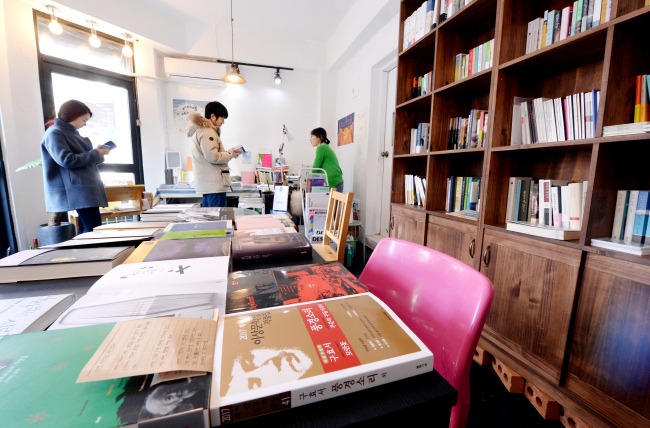
Bathhouses give way to jjimjilbang, gentrification
Bathhouses have long been fodder for films and television dramas, a timeless place where people not only wash their bodies but also cleanse their souls and make peace with others.
In reality, they are falling out of favor and being replaced by multipurpose “jjimjilbang (hot steam sauna)” and luxury spas equipped with fun-oriented functions.
Jjimjilbang are particularly popular among women in the wake of the “Korean wave” boom. The New York City-based version of women’s fashion magazine Elle featured special coverage of jjimjilbang in its 2015 December edition. Female Japanese tourists to Korea drop in at the sauna as a “must visit” part of their itinerary, intrigued by customs such as wearing a twisted donut-shaped towel on their head, and eating boiled eggs and shik-hye, a sweet, rice-based traditional Korean beverage.
As for the almost extinct public bathhouses, they are largely scattered across the countryside and smaller cities, where traditional habits haven’t died out and older people exercise a simpler lifestyle.
In cities on the other hand, where urbane, cosmopolitan tastes abound, the handful of remaining bathhouses have been refashioned into multipurpose cultural spaces for artists and neighbors.
The Hanghwa Bathhouse in Ahhyeon-dong in Seoul was refurbished to offer programs in performance art, theater, publishing and architecture, among other activities. Various exhibitions, plays and lectures are being held there before the building is eventually demolished for town redevelopment next year.
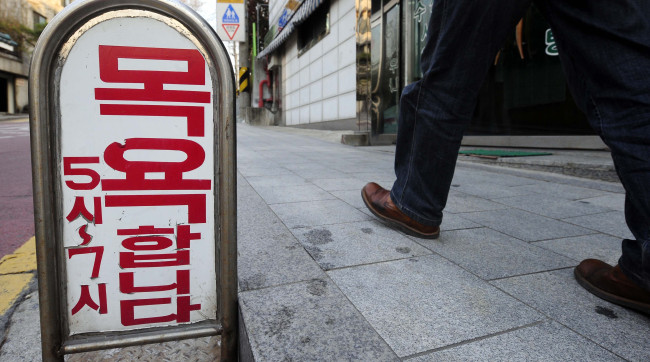
Tailor shops carry on blighted industry
The blight of tailor shops in Korea has been less lamentable compared to other tailor-made businesses, supported by loyal customers with age-old tastes as well as suave urbanites willing to splurge on a gorgeous, gentrifying fit.
Their plight has been coming. Mass-produced, ready-made clothes have flooded the retail and mom-and-pop stores since the early 2000s. Many tailors have either retired or switched their trade and fresh blood coming in for apprenticeships is weak.
Tailors point out that the best suit is one that fits the body neatly. It usually takes a clothier one to two days to assemble a piece, with prices ranging from $500 to several thousand dollars or more. With the advent of the internet it has become easier to follow the latest trends from Europe, they say, compared to the past, when the newest fads took two to three years to filter down to consumers.
One way for the suit makers to survive in this postindustrial economy is to be “postmodern”: aiming for the niche segment of highbrow customers with an eye for bourgeois, sui generis styles. They take pride in producing a one-of-a-kind suit that is smooth around the edges and body.
By signing clothes-mending contracts with global luxury brands such as Hermes, Loro Piana and Giorgio Armani, some front-runners are keeping an unassailable lead. The top-of-the-industry tailors -- many who work in the fashionable Cheongdam-dong area in Seoul -- take home an about $50,000 salary.
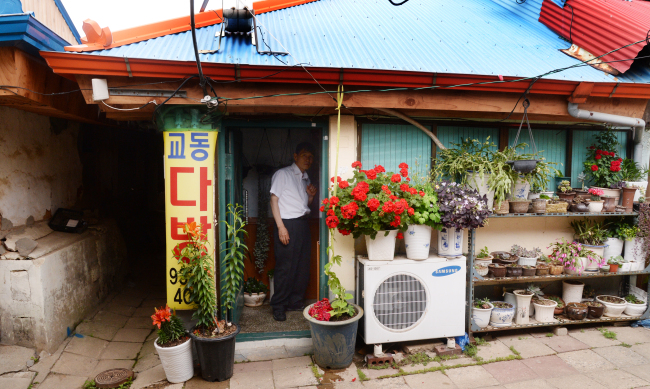
Dabang, a cocoon of saccharine desires
Amid the swarming of coffee shops across Korea, one traditional coffeehouse in northern Seoul has firmly stood its ground for six decades. Hangnim Dabang near Daehangno in Hyehwa-dong is a snug, antediluvian place frequented by romantics and idealists, a hideaway frozen in time.
Nestled in the backstreet of the university town famous for theater, music and art, the “dabang” -- meaning a traditional coffeehouse -- was where famed intellectuals, poets and novelists gathered and students fomented their democratic yearnings underneath the dictatorship of the 1980s.
When one visits the exotic salon, relics from the past, including LP records and players, framed sepia photographs and wooden wine racks, bring visitors back to their yesterdays.
The dabang’s signature coffee and cheesecake are one of a kind, brewed with care by the owner, a coffee maniac. He says he likes the students that come to the coffeehouse and debate intensively about art, literature, music and politics. But he also stresses that he wishes people to come without any fantasy or prejudgment.
Compared to the international coffee chains whose capitals are homogenizing the tastes of consumers worldwide, Hangnim Dabang is a rare species that has stood the test of time. Visitors hope that they will be able to sip the same bittersweet coffee years later, pensively recalling their exuberant youth.
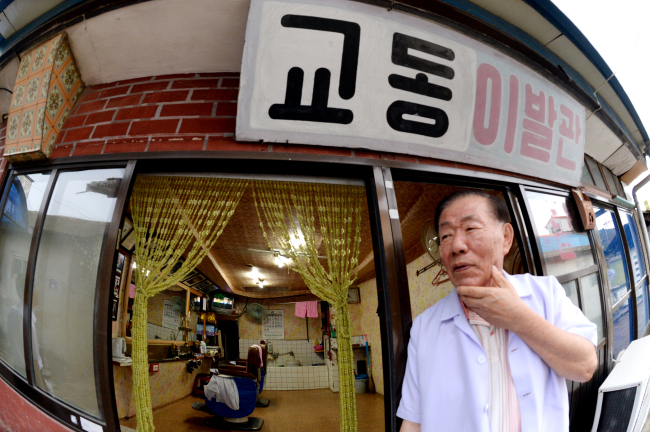
Barbershops sell timeless, priceless services
Before the advent of hair salons, Korean men got their hair cut at barbershops, unmistakably identified by the spinning blue, white and red pole.
The interior of a typical barbershop is filled with timeworn relics: cushy but squeaky chairs, a disposable calendar with dates written in a large Latin font, a national flag of South Korea, a kerosene heater with a big pot of water on top, and certificates, plaques and photographs of visiting celebrities lined up beneath the ceiling.
For those used to posh, prim hair salons, the overall ambience is decrepit, grubby and shabby, bordering on discomfort. Most barbers today are in their 60s and over, but they use their razors and scissors with virile energy and precision.
Being a barber was a profitable business in the 1960s, ’70s and ’80s. Men and women went to barbershops and hair salons separately, and hairstyles were more or less the same for men. The three most popular hairstyles were: “sang-go,” which was modeled after a military cut; “sports,” with shortly trimmed hair; and “high color,” that combed the hair to one side.
Although the number of customers has dropped sharply since the 1990s, the few remaining shops survive on a core breed of loyal clients, mostly senior men. As some customers are too old and sick to go outside, some barbers provide service at their residence or senior homes, lugging their kits with them.
The barbershops’ demise has been exacerbated by hanky-panky schemes that have proliferated over the years, with some male customers and female workers engaging in prostitution, leading to a government crackdown.
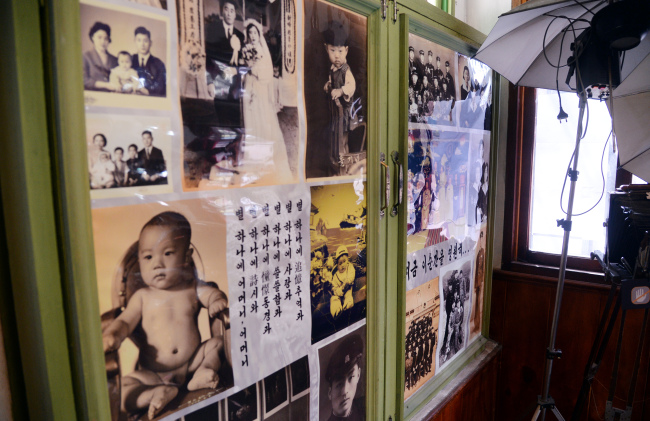
Photo studios still capture rare moments
The “Kodak moment” has long been a thing of the past. With digital cameras and smartphones being staple items for many, film cameras have faded into the midst of history.
Along with it followed the decline of photo studios, a presence that was appreciated in every town throughout the country. As the life of a Korean is filled with important dates -- the 100th day relationship celebration, one-year anniversary, school commencement, graduation, wedding anniversaries, 60th birthday, and so on -- Koreans like to take photographs to mark these occasions.
Abetted by the popularity of film cameras, these studio photographers were extremely popular from the 1970s through the 1990s. They also took pictures during national holidays, alumni gatherings and school picnics, touring all around the country to capture the moment forever. People mostly come for passport and license photos these days.
However, a growing number of youngsters have started to take a fancy to film photography. Charmed by the process of developing photographs, they take pictures with film cameras and take them to studios, where the shots are printed as a keepsake. Black-and-white photos last long and give off a warm, nostalgic feel, many analogue fans say.
Scores of newlyweds have visited photo studios in Seoul, inspired by the country’s retro-themed movies and dramas harking back to the late 1980s and ’90s. In front of a backdrop filled with props like iron doorknobs, a round clock, typewriter and telephone, they pose innocently as their parents did decades ago.
By Joel Lee (joel@heraldcorp.com)








![[Graphic News] More Koreans say they plan long-distance trips this year](http://res.heraldm.com/phpwas/restmb_idxmake.php?idx=644&simg=/content/image/2024/04/17/20240417050828_0.gif&u=)
![[KH Explains] Hyundai's full hybrid edge to pay off amid slow transition to pure EVs](http://res.heraldm.com/phpwas/restmb_idxmake.php?idx=644&simg=/content/image/2024/04/18/20240418050645_0.jpg&u=20240419100350)





![[From the Scene] Monks, Buddhists hail return of remains of Buddhas](http://res.heraldm.com/phpwas/restmb_idxmake.php?idx=652&simg=/content/image/2024/04/19/20240419050617_0.jpg&u=20240419175937)

![[KH Explains] Hyundai's full hybrid edge to pay off amid slow transition to pure EVs](http://res.heraldm.com/phpwas/restmb_idxmake.php?idx=652&simg=/content/image/2024/04/18/20240418050645_0.jpg&u=20240419100350)

![[Today’s K-pop] Illit drops debut single remix](http://res.heraldm.com/phpwas/restmb_idxmake.php?idx=642&simg=/content/image/2024/04/19/20240419050612_0.jpg&u=)